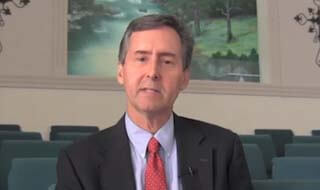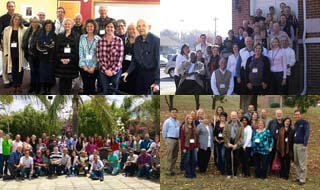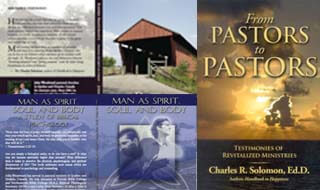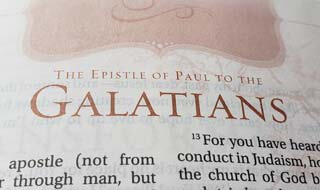A Response to “A Critique of the ‘Exchanged Life.'”1
A. Introduction
When it comes to critiques and responses, one is reminded of the saying, “truth can always stand scrutiny.” Therefore, if we care about being workers who do “not need to be ashamed, rightly dividing the Word of truth” (2 Tim. 2:15), this kind of dialog can be constructive. The basic theology that the journal article takes exception to has deeper roots than Hudson Taylor’s testimony and the association of ministries that have rallied around this message since 1970. If we wanted to accentuate a larger heritage, this model could be called “Keswick Counseling” (fn 2). Although not without their critics, writers like Evan Hopkins, Ruth Paxson, Jessie Penn-Lewis, Hannah Smith, Andrew Murray, Watchman Nee, Oswald Chambers, and Ian Thomas have stood the test of time in blessing generations of believers who “hunger and thirst for righteousness” (Matt. 5:6). (See the inventory of international publisher, Christian Literature Crusade: www.CLCUSA.org.)
Whatever one’s model of sanctification, we should agree that God calls us to experience the fullness of the Holy Spirit: “And do not be drunk with wine, in which is dissipation; but be filled with the Spirit” (Eph. 5:18). The question is, How does New Testament theology define the process of doing so?
We also need to be up front in admitting that no one has perfect objectivity; we are all biased to some degree. That bias may be negative (due to a poor version or example of this perspective) or positive (due to the personal benefits received). Obviously, we who defend the Keswick view of Romans 5-8 have tasted–even if imperfectly–the life more abundant that Christ promised us. Those who have the privilege of serving in a clinical setting have the opportunity to learn with counselees how the truth of our union with Christ can be practically understood and appropriated. Considering some of the testimonies of transformational change could help level the playing field as the theological issues are debated.2
Robert Pyne and Matthew Blackmon’s (the authors’) summary and evaluation of the Exchanged Life teaching is drawn from an extensive study of a variety of authors as formalized in statements of the Association of Exchanged Life Ministries (AELM). They concede that many have been personally helped by this understanding of sanctification. They also acknowledge significant diversity among authors and ministries that hold a common perspective on the way to spiritual victory.
This theology and testimony was declared by the apostle Paul in Galatians 2:20: “I have been crucified with Christ; it is no longer I who live, but Christ lives in me; and the life which I now live in the flesh I live by faith in the Son of God, who loved me and gave Himself for me.” (Although this text is probably the most concise summary of the theology embraced by “Exchanged Life” proponents, it was not quoted in the article.) Although this response is by no means a complete rebuttal of the journal article, it may give some preliminary assistance to concerned readers. We will first discuss the merit of some of Pyne and Blackmon’s concerns.
B. Valid Concerns
1. The problem of focusing on self instead of God
Since many Exchanged Life authors emphasize the believer’s new identity and spiritual regeneration, this can eclipse the all-important focus on the supremacy of God. The authors comment, “With a continuing focus on self, even in the name of virtue, one may persist in forsaking God” (p.156). Theodore Monod’s classic sermon titled “Looking unto Jesus” (Heb. 12:1,2) is a profound remedy to a misdirected focus.3 Another vital theme to counteract a self-preoccupation is the prescription of Romans 8:5: “For those who live according to the flesh set their minds on the things of the flesh, but those who live according to the Spirit, the things of the Spirit. For to be carnally minded is death, but to be spiritually minded is life and peace.” However, one of the “spiritual” truths upon which we should set our gaze is the believer’s union with Christ (Rom. 6:3-6).4 The authors’ point is valid: “Therefore any reflection on the believer’s new condition in Christ should be Christ-centered, not self-centered” (p.150). In Exchanged Life counseling, the goal is to functionally replace “the self-life” [flesh] with the “Christ-Life.”5
We wholeheartedly concur with the worship orientation espoused by Jonathan Edwards as drawn from 2 Corinthians 3:18: “But we all, with unveiled face, beholding as in a mirror the glory of the Lord, are being transformed into the same image from glory to glory, just as by the Spirit of the Lord” (p.157). However, this worshipful gaze is complementary to the Exchanged Life, not contrary to it.
2. The problem of an elitist attitude
Although those who have been brought to a new level of fellowship with Christ and victory over willful sin would naturally be excited about this discovery, it could lead to a proud, divisive attitude. Book titles such as Hudson Taylor’s Spiritual Secret, and They Found the Secret (V.R. Edman) can create an esoteric impression about the “secret.” Even though “Christ in you, the hope of glory” is described in Scripture as a “mystery,” it need not be considered mysterious (Col.1:27).
The authors charge that Exchanged Life writers “confuse sanctification with enlightenment” (p.149). This is another warning to heed. A theological understanding of sanctification (whether Keswick or Reformed), is no substitute for humility, faith, and godliness. Although we need to “know” that the old man is crucified, this must be reckoned personally through faith and yieldedness (Rom 6:6-13).
3. The problem of minimizing the responsibility for personal sins
The authors criticize Exchanged Life writers for having “too low a view of personal sin.”(p.151) When the Christian is designated a “saint” (1 Cor. 1:2) with an essential nature that “delights in the law of God” (Rom. 7:22), some may therefore minimize their personal responsibility for any sinful choices. Just as the world and devil are sinful influences, so is the flesh (Rom. 7:18). However, Paul differentiated his flesh from his personhood as the functional prompting to sin. He confessed in Romans 7:18-20: “For I know that in me (that is, in my flesh) nothing good dwells; for to will is present with me, but how to perform what is good I do not find. For the good that I will to do, I do not do; but the evil I will not to do, that I practice. Now if I do what I will not to do, it is no longer I who do it, but sin that dwells in me.” However, when the believer sins, he cannot evade personal responsibility. Likewise, sins of commission or omission should grieve the conscience just as they grieve the Holy Spirit (Eph. 4:30; Acts 23:1; Psalm 32). Sin should be confessed and renounced (1 John 1:9; Heb. 12:1). Our attitude should echo with the Psalmist, “Search me, O God, and know my heart; Try me, and know my anxieties; And see if there is any wicked way in me, And lead me in the way everlasting” (Psalm 139:23,24).
4. The problem of complacency regarding spiritual growth
Exchanged Life authors may so articulate and emphasize the importance of appropriating one’s identification with Christ–and appreciating the newness of the new creation–that they underemphasize the need for spiritual growth. A popular Exchanged Life author advocated “giving up Christian values” as part of the process of living by grace. Even though moralism may become legalistic when done in self-effort, Scripture exhorts value-based growth in character qualities. 2 Peter 1:5-9 directs us, “But also for this very reason, giving all diligence, add to your faith virtue, to virtue knowledge, to knowledge self-control, to self-control perseverance, to perseverance godliness, to godliness brotherly kindness, and to brotherly kindness love. For if these things are yours and abound, you will be neither barren nor unfruitful in the knowledge of our Lord Jesus Christ. For he who lacks these things is shortsighted, even to blindness, and has forgotten that he was cleansed from his old sins.” Exchanged Life authors need to dread the possibility of license as much as legalism.6
5. The problem of redefined terminology
The authors allude to Luther’s slogan that we are “at the same time righteous and a sinner” (p.136). Although Exchanged Life writers emphasize the believer’s essential identity as a saint, we need not deny the traditional phrase that we are also “sinners saved by grace.” The former speaks of the spirit; the latter speaks of behavior. When we are celebrating God’s grace in salvation, it is appropriate to humbly identify with our unworthiness–sinners (Rom.3:23; James 4:8; 5:16).
Since the church is accustomed to speaking of the “old nature” and the “new nature,” we must be cautious about how these terms are potentially misunderstood. When someone hears an Exchanged Life teacher state that the old nature was crucified with Christ, he will likely respond the way Miles Stanford did (criticizing “one naturism”–fn. 42). Since these phrases are not accurate translations of New Testament terminology anyway, it seems wise to clarify issues related to sanctification by using accurate terms and definitions.7
C. Responses to the Critique’s Major Objections to Exchanged Life Teaching
1. Defending trichotomy
Many of the authors’ concerns hinge on their rejection of the tripartite makeup of man. They rightly quote me and others who affirm the value of the soul/spirit distinction for accurately understanding regeneration and sanctification. They note, “…without the anthropo-logical foundation of trichotomy Exchanged Life theology loses its most distinctive message.”(p.150) Thankfully, they do observe how Exchanged Life authors clarify certain theological issues via trichotomy (p.145). However, the article does not quote the New Testament’s most definitive statement of this crucial aspect of biblical anthropology: “Now may the God of peace Himself sanctify you completely; and may your whole spirit, soul, and body be preserved blameless at the coming of our Lord Jesus Christ. He who calls you is faithful, who also will do it” (1 Thess. 5:23,24). Trichotomy is criticized as being scientifically suspect (p.149; Cf. fn.64). References to scientific objections can be dismissed outright, however, since–by definition–science deals only with empirical knowledge. No experiment can prove data about the non-material realm (soul, spirit, angels, or God). Therefore the issue of man being one, two or three “parts” must be determined exclusively by biblical revelation.
Some of the confusion about Exchanged Life writers’ statements relates to an inconsistent model of man used in this literature. While Needham, Edwards, and Stanford apparently write from a dichotomous perspective, Hall, Solomon, Gillham, Anderson, Stanley, et.al., emphasize the importance of the soul/spirit distinction. So, without the necessary clarification of soul and spirit, Exchanged Life authors are criticized for stating that “everything is new in Christ” (Stanford), and “we are now thoroughly renovated saints” (Edwards–pp.134,135; fn 19). These phrases more precisely refer to the believer’s new spirit, otherwise Exchanged Life teaching is accused of exaggerating the impact of regeneration.
The authors seem to contend for monism (or at least a “multifaceted” view of man). They oppose Evans’ negative comments about the fleshly, depraved body of man as reminiscent of Gnostic dualism. However, the reference to Gnosticism functions here as guilt by association. Surely, Paul cannot be accused of heathen influence when he confides, “But I discipline my body and bring it into subjection, lest, when I have preached to others, I myself should become disqualified” (1 Cor. 9:27 Cf. 2 Cor. 5:1-5). Our Lord made a similar distinction between soul and body: “And do not fear those who kill the body but cannot kill the soul. But rather fear Him who is able to destroy both soul and body in hell” (Matt. 10:28). The problem with the believer’s body is its vulnerability to sin, not its material nature (Rom. 6:6b). 1 Corinthians 6:13b notes the dignity of the body: “Now the body is not for sexual immorality but for the Lord, and the Lord for the body.”
The authors’ biblical objection to trichotomy comes primarily from word studies. It is imperative, however, to discern how progressive revelation in the Bible edits the meaning of “soul” and “spirit.” Just as Old Testament word studies could be used to contradict the triune nature of God (Deut. 6:4), so they could be used to oppose the tripartite makeup of man. The distinction of persons in the Godhead is progressively revealed (Matt. 28:19); similarly, the soul/spirit distinction is revealed though the New Testament epistles (1 Thess. 5:23; Heb. 4:12).
This writer contends for an expression of man’s makeup designated “holistic trichotomy.” Instead of seeing man as a spirit that has a soul and lives in a body, man’s unified personhood is emphasized. Just as Needham could protect biblical dichotomy from a Gnostic denigration of the body (Matt. 10:28; fn.19), so holistic trichotomy can affirm the ontological distinction of soul and spirit without requiring emphasis on compartmentalization.8
The dichotomist and monist have their own challenges when it comes to clarifying sanctification. Reformed theologian L. Berkhof affirms that at regeneration, the governing disposition of the believer’s heart is made holy. Yet, man is simultaneously charged with being totally depraved.9
2. Defending forensic justification
Although the authors give credit to E.L teachers who faithfully state and protect the doctrine of justification by faith (fn.17), they quote Luther’s opponent, Osiander, as proof that being righteous in one’s spiritual nature impinges on legal justification by grace alone (fn.17,76). As stated above, a rejection of trichotomy inevitably leads to this kind of confusion. Nevertheless, the apostle John wrote: “Whoever has been born of God does not sin, for His seed remains in him; and he cannot sin, because he has been born of God” (1 John 3:9). Similarly, Paul declared, “… put on the new man which was created according to God, in true righteousness and holiness” (Eph. 4:24). With the clarification that this “new man” refers primarily to the regenerate human spirit, we can safely maintain the Reformation’s view of legal justification. (The context of the Luther-Oriander debate was Rome’s view of meritorious, sacramental righteousness that denied the doctrine of Christ’s imputed righteousness. No Exchanged Life teacher would accept the Roman Catholic view.)
Exchanged Life teaching would agree that practical righteousness (in character, words, and behavior) is an aspect of progressive sanctification. While the believer’s spirit has been made righteous (Eph 4:24), he still needs to walk in the Spirit so as not to fulfill the lust of the flesh (Gal. 5:16; Cf. Rom. 6:13,16).10
3. Defending individual identification with Christ
The Critique claims that the interpretation of “the old man” cannot be individualized; it refers to the community [fn. 69,80]. However, the corporate aspect of being the new man comes from the imagery of believers as the Body of Christ (Eph. 5:30). Just as the believer is the temple of God individually (1 Cor 6:19,20) and collectively (1 Cor. 3:16), even so the born again believer is spiritually the new man and also participates in the corporate expression of that new man. Since the New Testament epistles are mostly written to churches, the community aspect would naturally be included. However, denying the individual meaning of identification with Christ lays the axe to the root of communal union with Him. Although Bonhoffer (who was favorably quoted) applied discipleship to community (especially relevant in the social unrest of Nazi Germany), his application should not dictate biblical interpretation (fn.78).
The authors object to the Exchanged Life emphasis on the New Covenant’s promise of the believer’s “new heart” (Ezek. 36:26; Jer. 31:31-34). (This theme is expounded, for example, in Edward’s book, Revolution Within.) The Critique states that “Ezekiel’s promise of a new heart is part of a broader promise of Israel’s restoration that includes other features not yet realized (Ezek. 36:22-36). The New Covenant promises begin to find their fulfillment in the New Testament, but none of these benefits are yet fully realized. From this perspective, Exchanged Life theology offers an overrealized eschatology.”(fn 67) One wonders why this covenant’s final, comprehensive fulfillment in God’s dealings with Israel negates the reality of the believer’s new heart: “Therefore, if anyone is in Christ, he is a new creation; old things have passed away; behold, all things have become new” (2 Cor. 5:17; Cf. John 7:38). Just as the Abrahamic Covenant includes the blessings of the gospel to individual Gentiles (Gen. 12:3; 15:6; Gal 3:5-14) even so the New Covenant includes the individual regeneration of believers in the covenant Christ ratified in His death and resurrection (Matt. 26:28; 2 Cor. 3:1-18).
4. Defending a victorious life
In the New Testament God describes and offers victory over bondage and willful sin patterns: “Now thanks be to God who always leads us in triumph in Christ, and through us diffuses the fragrance of His knowledge in every place” (2 Cor. 2:14). “For what the law could not do in that it was weak through the flesh, God did by sending His own Son in the likeness of sinful flesh, on account of sin: He condemned sin in the flesh, that the righteous requirement of the law might be fulfilled in us who do not walk according to the flesh but according to the Spirit” (Rom. 8:3,4). However, this victory is not just an experience to achieve; it is a relationship to maintain.11
The authors have a pastoral concern for the person who may feel disrespected by Exchanged Life doctrine and “for those insiders who become deeply discouraged. If they honestly try to live out the message of Exchanged Life but continue to struggle spiritually, they can only conclude that they have failed once again” (p.148). These are legitimate concerns. However, the answer is not in rejecting the message of identification with Christ. Rather, the pastoral counselor should guide a struggler in how to appropriate Christ as Life by faith (Rom. 6:11-14). Victory comes through a Person, not a teaching. Also, the fuller context of God’s provision should include not only the cross of identification (Gal. 2:20), but also the Cross of victory over Satan (Col. 2:15), and the Cross of daily surrender and discipleship (Luke 9:23).
5. Defending personal cooperation
The authors’ description of the Exchanged Life includes “doing what is right without a struggle.” If this concept is taken out of context, no wonder the authors would conclude that this view is “confusing and unrealistic.”[p. 148] Any complete expression of this life of victory would balance God’s gracious influence and enablement with the believer’s personal responsibility. This balance is illustrated in Philippians 2:12,13: “Therefore, my beloved, as you have always obeyed, not as in my presence only, but now much more in my absence, work out your own salvation [from the flesh] with fear and trembling; for it is God who works in you both to will and to do for His good pleasure.” We are to cooperate with God, fighting the good fight of faith [not self-effort] (1 Tim. 6:12). Exchanged Life writers typically emphasize the rest of grace because of the blessed relief the abiding life brings. As our Lord announced, “Come to Me, all you who labor and are heavy laden, and I will give you rest. Take My yoke upon you [especially the yoke of surrender and identification] and learn from Me, for I am gentle and lowly in heart, and you will find rest for your souls. For My yoke is easy and My burden is light” (Matt. 11:28-30).
6. Defending a “shortsighted approach to spirituality”
While the repeated emphasis on grace and identity in Exchanged Life authors may draw the label of shortsighted spirituality, this need not be the case.12 The authors’ working definition of the view they critique is that “believers will experience victory and happiness in the Christian life only by recognizing and living out the reality of the inherent change already produced in them at conversion.”(p.133) It is always risky for a critic to formulate a definition of what he is critiquing. The tendency to erect a straw man and demolish it is too tempting (especially since we are still sinners…). However, this definition omits God, Christ, the Cross, faith, and the Holy Spirit. While it is not a false statement, it is obviously truncated (as revealed in the article’s extensive quotes from Exchanged Life sources).13
There is an admitted weakness in using an extra-biblical name (Exchanged Life) for a model of sanctification. It inclines one to assume the answer is in this camp exclusively–or that the deliverance is in a teaching, rather than Christ Himself. Such is not the case. Christ, not a doctrine, is our redeemer and sanctifier: “But of Him you are in Christ Jesus, who became for us wisdom from God–and righteousness and sanctification and redemption” (1 Cor. 1:30). Christ affirmed, “Abide in Me, and I in you. As the branch cannot bear fruit of itself, unless it abides in the vine, neither can you, unless you abide in Me. I am the vine, you are the branches. He who abides in Me, and I in him, bears much fruit; for without Me you can do nothing” (John 15:4,5).
Obviously, there are saints who have intuitively lived a victorious life through surrender and trust without a detailed understanding of the theology or Romans 6-8.14 On the other hand, many who specialize in studying and teaching these doctrines may neglect an intimate walk with God.
Victory comes through an abiding relationship with Christ, not an abstract formula. Christ is our Savior, Lord, Life, Liberator, and Leader (Rom. 10:9,10; Col 3:4; John 8:32; John 10:1-10). Spiritual disciplines are important, but are to be used in the context of grace, not law. “For by grace you have been saved through faith, and that not of yourselves; it is the gift of God, not of works, lest anyone should boast. For we are His workmanship, created in Christ Jesus for good works, which God prepared beforehand that we should walk in them” (Eph. 2:8-10; Cf. 1 Pet. 2:1,2; Rom 8:15,16).
Do “Galatians 2:20 Christians” need to grow in love for God by renewing their affections in worship? Yes!15 Do they rejoice in Christ’s continued intercession on their behalf? Yes! Do they set their hope fully on the grace to be revealed at Christ’s return? Yes! Are they to cooperate with God’s Spirit in ongoing spiritual growth and behavioral transformation? Yes! (p.157)
Years ago, a poll of pastors indicated that their favorite daily devotional was Oswald Chamber’s, My Utmost for His Highest. Here is an example of a writer who promotes practical godliness in the Body of Christ without being marginalized by a label (Exchanged Life). He believed in the trichotomous model of man, brokenness, identification with Christ, and the necessity of daily abiding.16 Like Chambers, many have found in the Word of God–and the Keswick heritage–“a more God-centered, more realistic, more hopeful, more liberating, and more delightful” Christian spirituality. Let us value the deeper life devotional heritage as well as the gifts and writings of godly men and women from differing evangelical theological traditions. May we be teachable and discerning; “Test all things; hold fast what is good” (1 Thess. 5:21).
2/2/2007
~~~~~~~~~~~~~~~
1 Robert A. Pyne and Matthew L. Blackmon, “A Critique of the ‘Exchanged Life.'” Bibliotheca Sacra, vol. 163, (April-June 2006), 131-57. Dr. Pyne’s forthcoming book, Lifespace, evidently deals with core issues of “the practice of life with God.” The summary of these themes on his website sounds edifying, but not mutually exclusive to the theology he critiques here. A volume that may help bridge the gap between the Exchanged Life perspective and the Godward focus Pyne and Blackmon advocate is The Ultimate Intention, by DeVern Fromke (Sure Foundation).
2 See Charles Solomon, Handbook to Happiness, ch. 8; https://gracenotebook.com/category/testimonies/; John Best, Exchanged Lives! Stories of people who discovered that they were eagles and how to soar by their union with Christ (Dallas, Texas: Exchanged Life Ministries); V. Raymond Edman, They Found the Secret (Zondervan).
3 Looking unto Jesus is available online at https://gracenotebook.com/looking-unto-jesus/ and in print from BTPorders@cs.com
4 See Grace Note, “Drawing the Right Conclusion.”
5 See F.B. Meyer, The Self-Life for the Christ-Life.
6 See Grace Note, “Your Garden of Virtues.”
7 See Charles Solomon, Gems and Jargon (GFI) and Definition of Terms at https://gracenotebook.com/definitions/.
8 A holistic emphasis would answer the authors’ criticism that worship also involves the soul and body. (fn 62) We agree. For a more complete response, see this writer’s e-book: Man as Spirit, Soul, and body: A Study of Biblical Psychology
http://www.gracenotebook.com/trichotomy_bk.pdf and http://www.BiblicalPsychology.net
9 L. Berkhof, Systematic Theology, 469.
10 See “The Perfected and Progressive Aspects of the Believer’s Sanctification,” https://gracenotebook.com/the-perfected-and-progressive-aspects-of-the-believers-sanctification/ and “Made Right to Live Right: A Study of Justification” pts 1-3
11 Dr. Gerald McGraw gives a comprehensive presentation and defense of this theology in his book, Launch Out: A Theology of Dynamic Sanctification (Camp Hill, PA: Christian Publications). See the statement by the Christian and Missionary Alliance: https://my.cmalliance.org/resources/books/manual/manual.jspm [section H: Statements]
12 The Sonship Course in New Covenant sanctification may present the Christ-centered, grace-oriented, new identity approach to Christian living through a less objectionable model to those sympathetic to this Bibliotheca Sacra Critique (http://www.whm.org).
13 For a fuller expression of deeper life perspectives, see Elmer Towns, Understanding the Deeper Life – http://www.elmertowns.com/index.cfm?action=bksonline
14 For a Keswick exposition of Romans 5-8, see The Gospel for the Believer at http://www.gracenotebook.com/e_books.htm
15 “Galatians 2:20 Christians” is used here as referring to those who have come to know, reckon, yield, focus and walk in their identification and union with Christ (Romans 6:3-14). (This is not, however, a once-for-all status any more than “he who is spiritual” is (1 Cor. 2:15; Gal. 6:1).
16 Oswald Chambers, Biblical Psychology (Discovery House).
Rev. John Woodward, D.Min. serves as Executive Director of Grace Fellowship International in Pigeon Forge, TN.
www.gracefellowshipinternational.com
To comment on the Critique or this response, please e-mail john@gracenotebook.com
Copyright 2007 by John Woodward. Permission is granted to reprint for non-commercial use. Biblical quotations are from the New King James version, copyright 1987 by Thomas Nelson.

















